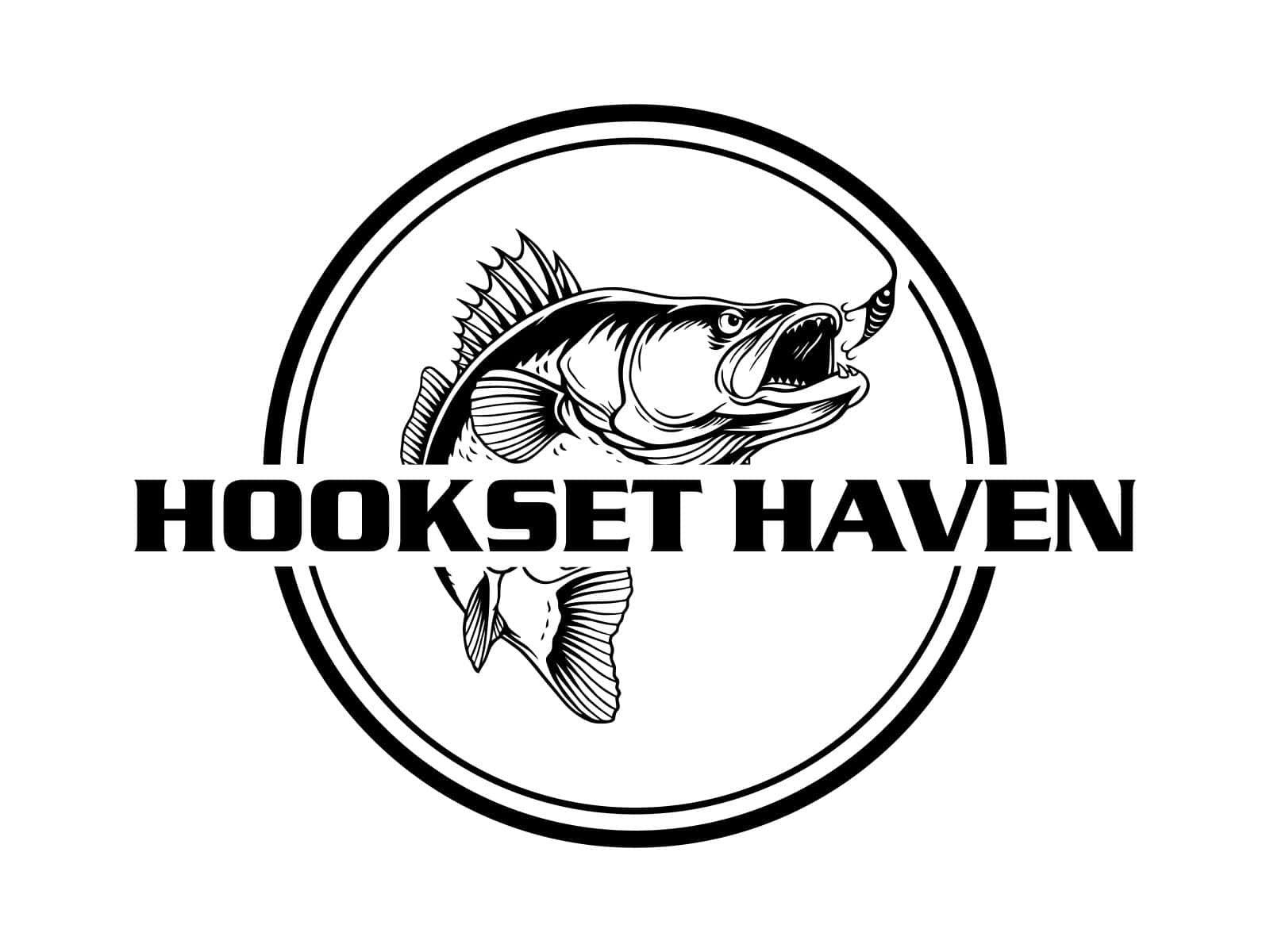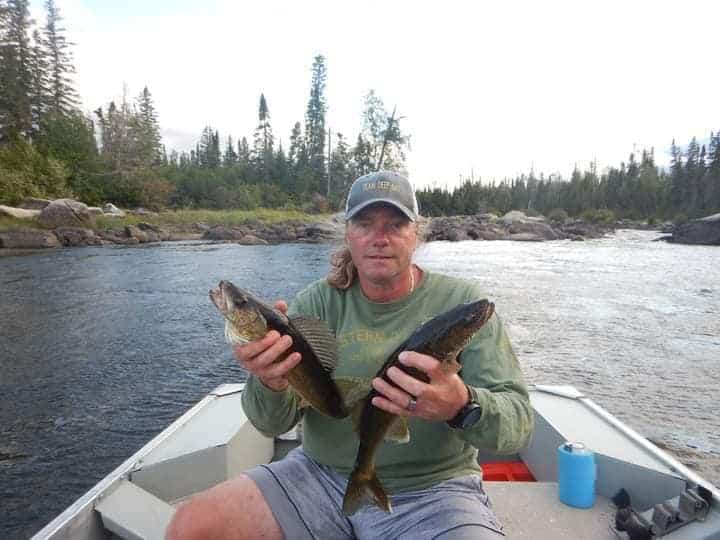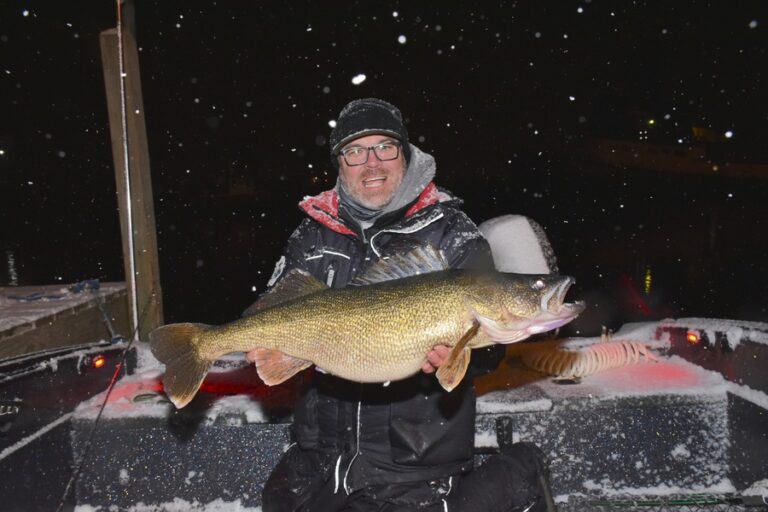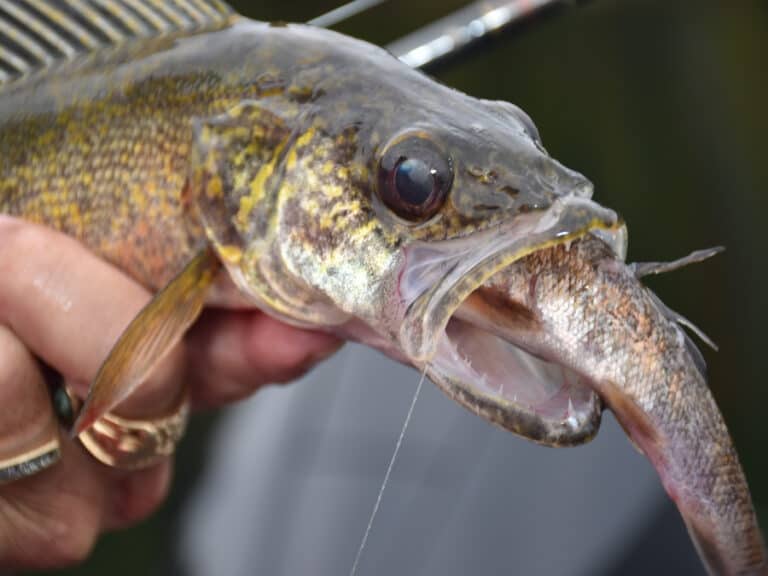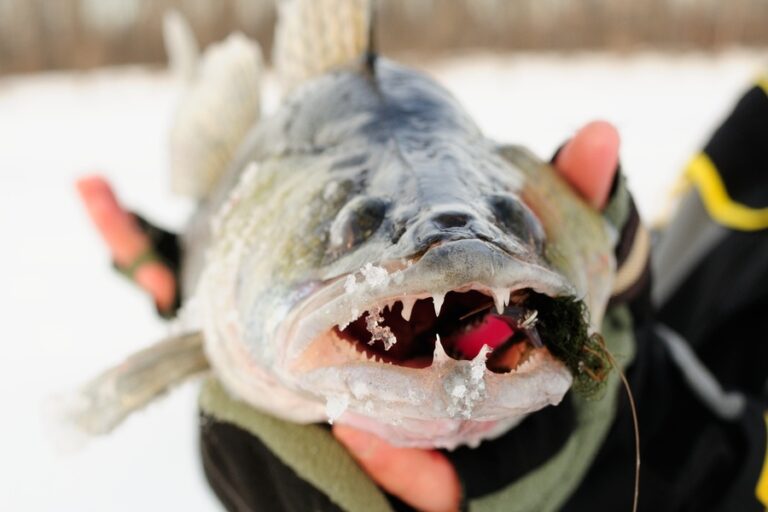Walleye Fishing on Sunny Days (How-To, Baits, Spots, Tips)
To catch walleye on sunny days, focus on deeper waters and shaded areas near structure like rock formations or weed beds. Use natural-colored lures or bright, reflective ones, and consider early morning or late evening when walleye are more active.
Keep an eye on water temperature and clarity, adapting your techniques accordingly. But there’s a lot more to fishing sunny days for walleye that we will cover in much greater detail.
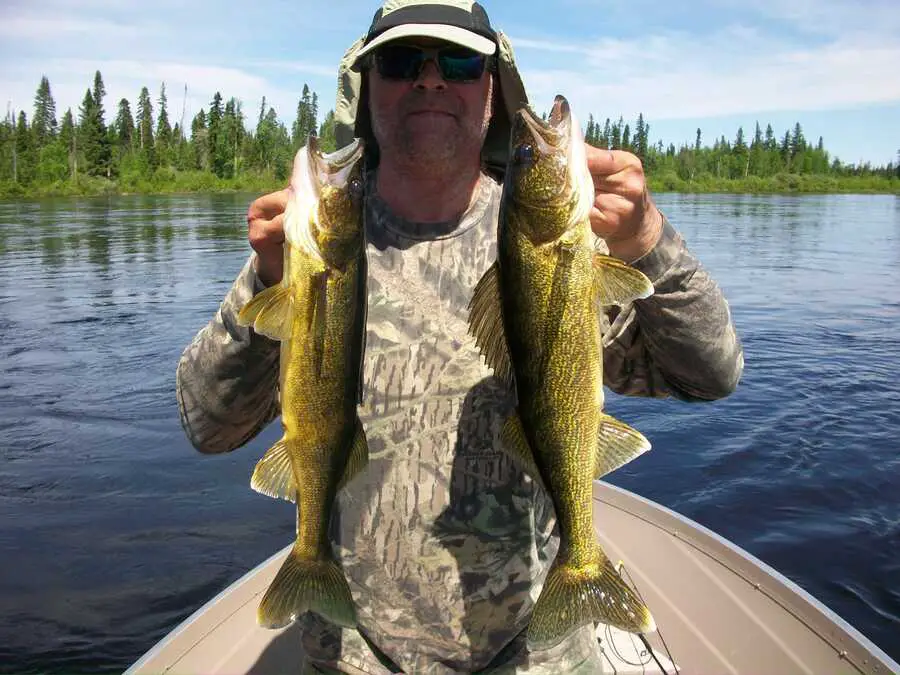
Table of Contents
Walleye Fishing on Sunny Days: Any Good?
Walleye fishing can be tough on sunny days as fish are down deep, holding tight to structure during the day. The best fishing on sunny days will be in the early morning and late afternoon when water temps are cooler and walleye are actively feeding.
During these reduced-light periods, walleye will move to shallower water and become more active feeding.
Tip: Opt for a quality fluorocarbon mainline and leader on sunny days. It will offer the best combo of sensitivity and underwater invisibility. Seaguar Red Label is a great option.
Walleye Behavior on Sunny Days
Sunny conditions typically have a sobering effect on walleye movement and feeding activity. Walleye will push to deeper water avoiding the bright overhead light where the water is cooler. In the daytime hours, walleye will avoid shallower waters and hold very tight to prominent deep structure like refs, rocks, humps, and ledges.
The prime feeding windows will be early mornings and late afternoons when walleye will move shallower (both horizontally and vertically) to feed. In these reduced light hours, walleye can be found in mid-depth areas around deep weed lines and ledges.
If you fish from shore, your best bet to catch walleye is late in the evening around sunset. Walleye may be within casting range of the shore or a dock.
Locating Walleye on Sunny Days
- Lakes: On clear sunny days, walleye are often found in deeper waters of lakes, seeking cooler temperatures and lower light levels. Look for them near drop-offs, deep weed edges, and submerged structures. Preferred depths can range from 15 to 30 feet, depending on the lake’s clarity and temperature.
- Rivers: In rivers, walleye may retreat to deeper pools or areas with strong current breaks. Depths of 10 to 20 feet can be productive, especially near features like bends, submerged logs, or rock formations.
Click here to learn how weather impacts walleye fishing. To learn how to catch walleye on cold days, check out this guide. To learn how to catch walleye on snowy days, check out this guide.
Structure & Cover
Table: Walleye Features on Sunny Days
| Feature | Description | Preferred Depths | Why Attractive on Sunny Days |
|---|---|---|---|
| Drop-offs | Transitional areas where shallow water meets deeper water, offering both feeding and hiding spots. | 20-30 feet | Provides shade and cooler water, essential on sunny days. |
| Humps | Underwater elevations that often gather schools of baitfish, attracting walleye. | 15-25 feet | Walleye use these for feeding while staying out of bright sunlight. |
| Deep Weed Edges | Edges where deep water weeds meet open water, providing cover and food sources. | 10-20 feet | Offers protection from sun and access to prey in shallower water. |
| Deep Rock | Areas with rocky bottoms in deeper water, ideal for walleye to ambush prey. | 20-30 feet | Cooler, shaded area preferred by walleye during bright conditions. |
| Points | Landforms extending into the water, often acting as stacking points for fish. | 15-25 feet | Shaded areas and depth changes offer relief from sunlight. |
| Reefs | Similar to humps but often found in larger water bodies; rich in food sources and cover. | Varies, often deeper | Reefs offer diverse habitats, which are advantageous on sunny days. |
| Ledges | Steep underwater cliffs providing depth variation and shelter. | Varies widely | Ledges provide depth shelter from sunlight and feeding opportunities. |
Seasonal Guide
Spring
Sunny days in spring can offer good fishing for walleye in shallow northern bays, the first to offer green vegetation of the year. While walleye will typically be in shallower water, on sunny days they will back off to deeper water in the 10-15 foot range. Live bait like shiners, fathead minnows, and jigs work great.
Summer
In summer, walleye push deeper into main lake basins and deep river holes. On sunny days, they will be down deep where the water is cooler and the sunlight is reduced. The best times to fish will be early morning and late afternoon.
Trolling crankbaits and spoons around deep lake humps, drop-offs, and ledges works great. In clear water, focus on natural colors like “ghost”, browns, and shad-colors. Use brighter colors in stained water. Drift fishing live bait and bottom bouncing are effective, too.
Fall
Fall is my favorite time of year to catch walleye. They will feed heavily as winter approaches and readily chase moving baits. Fishing will be best on sunny days in the early morning and late afternoon.
The sunny conditions will push walleye down deep during the day, but you’ll find them in medium-depth areas early mornings around deep weed edges, ledges, and points.
Winter
Sunny days in winter can offer excellent walleye fishing. If fishing on open water, focus on deeper humps and rock piles in main lake basins. Walleye could be on bottom or up mid-column. Ice fishing is also good on sunny days, early morning and late afternoon.
Focus on deep structure in 20-30 feet of water. Use brighter or UV-colored jigs and spoons. Jigging shiners and leeches work great. If you can dig enough holes, tip-ups rigged with dead or live shiners or suckers are fantastic.
Combining tip-ups with shiners and jigging is my favorite combo for locating and catching walleye in winter. It offers active and passive fishing and coverage of water depths.
Best Time of Day
The best time for walleye fishing on sunny days is early morning, from just before dawn until 2 hours after sunrise. This is best combination of reduced sunlight penetration and cooler temperatures. Late afternoon around sunset is also a great time.
How-To: Clear Skies Walleye Fishing
To catch walleye on clear sky days, focus on deeper water in the 25-40 foot range near deep structure like rock, reefs, ledges, humps, and drop-offs. Finesse fishing is the best as walleye will be docile and holding very tight to cover.
Use natural colors and fluorocarbon line to better target finnicky fish. The best times of the day to fish will be early morning, late afternoon, and after dark.
Recommended Techniques
Trolling
Trolling can be good on sunny days but you need to match your time of day with troll speeds. During the middle of the day, walleye are best trolled using bottom bouncers, worm harnesses, and very slowly trolled swimbaits.
Walleye will be docile and require slower troll speeds. Early morning and late afternoons, you’ll want to troll shallower structure faster using spoons, swimbaits, inline spinners, and crankbaits.
Jigging
Vertical jigging can be a very effective way to fish on clear sky days. Focus on deep structure during the day and shallower rock, ledges, and deep weed edges early mornings and late afternoons.
Ned rigs and dropshot rigs are especially effective for deeper walleye on sunny days. Make sure you match what walleye are eating and use braid mainline with a very long (15+) fluorocarbon leader for maximum sensitivity and stealth.
Casting
Casting for walleye on sunny days will be effective late afternoons and early mornings when fish are shallower. It will be very hard to present baits deep enough on sunny days to walleye with long enough casts.
Lipless crankbaits and heavier swimbaits are capable of sinking deep enough to target walleye mid-day on large lakes. These baits sink fast and can be retrieved in the strike zone tightly beside structure.
Drift Fishing
Drift fishing can be great in early morning around mid-depth weed edges, inside turns, rock, and ledges. I recommend using live shiners or suckers if legal. These are dynamite baits for hungry walleye on sunny days as their scales reflect a ton of natural light to draw in bigger fish.
Use a lead pencil weight on sunny days as they are heavier helping you maintain better line contact with your bait down deeper. Even more importantly, lead won’t reflect sunlight like titanium will making them a stealthier option.
Slip Bobber
Slip bobber rigs allow you to control depth and manage bait placement. On sunny days, walleye will be too deep but late evening and early mornings, some walleye may move into shallow enough water to make this an effective technique. Use live bait like shiners, alewives, and suckers.
Ice Fishing
Ice fishing can be very good on sunny days. Walleye will be most active early mornings and late afternoons. Focus on deep main lake basin structure like channels, humps, and ledges. Jigging and tip-ups are great options. Fathead minnows, suckers, and shiners are awesome bait options.
Use UV or glow in the dark jig heads and jigging lures for deeper daytime walleye jigging. This is even more important in dirty or stained water.
Table: Walleye Techniques on Sunny Days
| Technique | Recommended Conditions | Best Time of Day |
|---|---|---|
| Trolling | Deep water, large lakes, open water | Morning and evening |
| Jigging | Weed beds, rock piles, structure-heavy areas | All day, especially effective midday |
| Casting | Shallow waters, near shorelines, during dusk and dawn | Early morning and late evening |
| Live Bait Rigging | Variable depths, especially during spawning season | Throughout the day, peaking at dusk |
| Slip Bobber Fishing | Near structures in calm waters, especially in summer evenings | Late afternoon to evening |
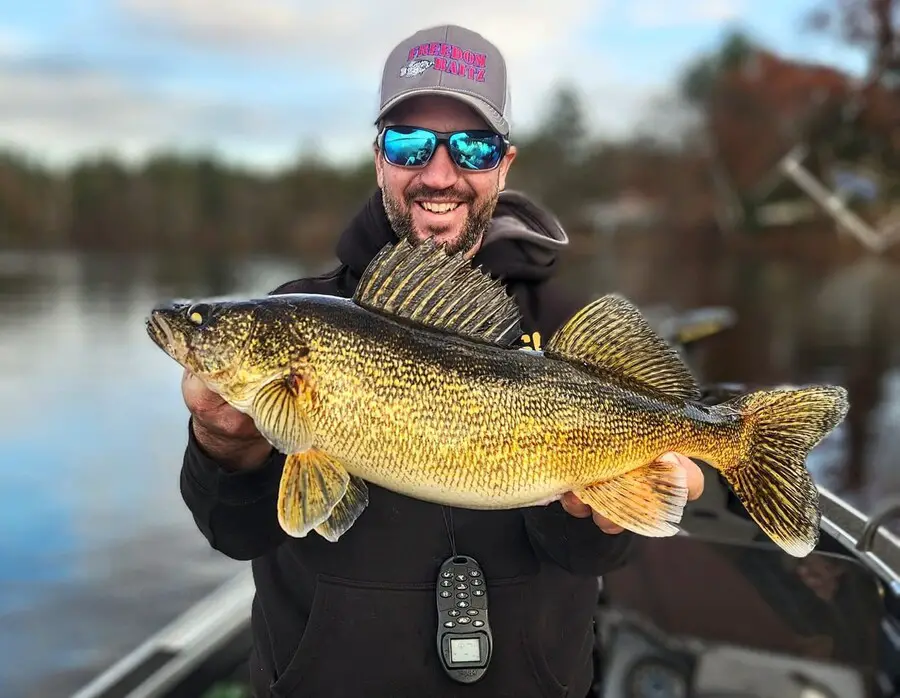
Tackle Recommendations
Select baits that mimic natural prey in clear waters, such as minnows, leeches, or nightcrawlers, and use bright or fluorescent colors like chartreuse, orange, or green in murky waters. Crankbaits and spinnerbaits are effective, especially in silver, gold, or natural fish patterns, to reflect sunlight and attract walleye.
Jigs work well near structures like rocks or weed beds; opt for jigs in natural colors like brown or green. In deeper waters, use trolling techniques with deep-diving lures in metallic or natural shades.
Soft plastics are versatile; use them in clear water with subtle colors like gray or white. Match lure size with the prevalent forage fish in the area. Consider the water clarity and depth when selecting lure types and colors for the best results.
The best line I can recommend for you on sunny, clear sky days is fluorocarbon. This line is extremely hard to see underwater making it ideal for midday finesse fishing.
Sunny Day Walleye Fishing Tips
- Target the transition zones where murky and clear waters meet, as walleye often use these areas for ambush during bright days.
- Utilize slender, more natural-looking lures that mimic the appearance and movement of live baitfish in sunny conditions.
- Experiment with subtle color variations in lures; slight changes can make a big difference in clarity and sunlight.
- Focus on fishing during the ‘golden hours’ just after dawn and before dusk when walleye are more likely to feed in shallower waters.
- Vertically jig over deep structures, as walleye may linger around these areas to escape the sun’s intensity.
- Try slow-trolling with a bottom bouncer rig to present the bait more effectively in deeper zones where walleye retreat.
- Cast near underwater points and edges, as walleye may use these as vantage points to feed on passing baitfish.
- Monitor wind direction and speed; a slight chop on the water can reduce sunlight penetration and make walleye more comfortable in shallower areas.
- Use longer casts to avoid spooking the walleye in clear water, as they can be particularly wary. I strongly recommend using fluorocarbon line for added invisibility in clear water.
- Incorporate scent attractants with your lures or baits, which can be especially effective when walleye are less active in bright light.
- Check areas with varying bottom compositions (mud to gravel transition zones), as these can be hotspots on clear, sunny days.
- Adjust the retrieval speed of your lure. A slower, more deliberate retrieve may be more effective in clear water conditions.
- Fish near submerged vegetation edges, where walleye may hide from sunlight while close to feeding areas.
Conclusion
Walleye tend to move deeper and stick close to structures like reefs, rocks, and ledges on sunny days, making early morning and late afternoon the prime time for fishing when they feed in shallower waters.
The best techniques include trolling in deep waters, jigging around deep structures, and casting near shorelines during dusk and dawn. Fluorocarbon line is almost mandatory to catch walleye. Natural-colored baits are effective in clear waters, while bright or fluorescent colors are suitable for murky conditions.
Frequently Asked Questions
What are the best walleye lure colors for sunny, clear days?
On sunny days, walleye are typically more attracted to lures in natural colors that mimic their prey, like silver, gold, or white. Bright and flashy colors, such as chartreuse or orange, can also be effective, especially in clear water, as they reflect more light and create a visual target for the fish.
What is the best water depth for walleye in summer?
During the summer, walleye often prefer deeper waters ranging from 15 to 30 feet, especially during the brightest parts of the day. They tend to move to these depths to find cooler temperatures and more stable environments, though they may come to shallower areas during dawn, dusk, or overcast conditions to feed.
What are the best locations for walleye fishing on sunny days?
On sunny days, look for walleye in areas with ample shade or cover, such as near underwater structures like rock piles, sunken trees, or weed beds. Also, consider deeper areas along drop-offs or where there’s a transition from shallow to deep water, as walleye may retreat to these cooler, darker depths when the sun is at its peak.
